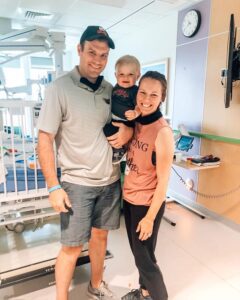The Lashoff family loves living in St. Louis; they’ve been there for six years and can’t get enough of it, from watching hockey at the Enterprise Center to marveling at the Gateway Arch. Ryder (10), Lyla (8), and Kayden (3.5) are privy to so much culture and fun activities. But to Kristin and her husband Matt, one of the best parts of St. Louis is the fact that they’re so close to St. Louis Children’s Hospital. This has been a tremendous resource as they’ve managed Kayden’s health journey: his dermal sinus tract, tethered spinal cord, and Chiari malformation type I (also known as a Chiari I malformation). Says Kristin:
“I’m a firm believer that everything happens for a reason, and you’re put in places and peoples’ lives for a reason. And we were put here to get the best help for our son.”
Kayden’s diagnostic journey was sometimes difficult, with contrasting and frightening information given from the first doctors to understanding how it might affect him in the future. But throughout this journey, Kristin has found comfort and support in community-building.

Recently, Kristin sat down with Patient Worthy to talk about Kayden’s story, what Chiari I malformation is, the challenges of parenting a child with a rare (or multiple rare) conditions, and their upcoming “Skate Under the Stars: A Rare Disease Celebration” event!
Kayden’s Birth
When Kristin was pregnant with her youngest son Kayden, everything seemed to be going smoothly. The doctors didn’t identify any potential health issues while Kayden was in the womb. Even labor went fine. However, after doctors placed Kayden in the warmer, they noticed something concerning. Kayden had a sacral dimple, an indentation or pit in the skin that appears on some infants at birth. Most sacral dimples are not cause for concern, though if the dimple is large or appears near a tuft of hair, skin tag, lump, or skin discoloration, it could be the sign of a spinal problem. In Kayden’s case, doctors were worried as there was a secondary dimple sitting a few inches above the first. Says Kristin:
“The hospital where I had him was not equipped to handle potential neurosurgical issues. They more or less flipped out, went to the extreme, and told us that Kayden needed to have surgery right away. We were also told that he would never walk. It was traumatic.”
Kayden, soon after, underwent a spinal ultrasound to determine what the potential cause of the dimpling was. While it came back with no issues, doctors noticed a potentially abnormal lesion that could signify a spinal dermal sinus tract, a rare spinal dysraphism (a condition in which the spine and spinal cord fail to form properly). Dr. Jennifer Strahle came to visit the family a few hours later, checking Kayden and ordering a brain and spinal MRI for him at just 1 day old. But doctors decided, at least at first, not to put Kayden through any surgical interventions.
By the time Kayden was five weeks old, he began having choking episodes; doctors believed that he was choking on his reflux. A pulmonary doctor diagnosed Kayden with an underdeveloped esophageal flange.
When Kayden turned six months old, he underwent another sedated MRI. This MRI confirmed the spinal dermal sinus tract but saw no sign of spinal cord tethering. The neurosurgeon, however, suspected that Kayden had a tethered cord. To set Kayden up for the optimal outcome, and to ensure his health and safety, the family decided to wait until he was one year old to have surgery to address these issues.
The Surgery – and a New Diagnosis
As Kayden grew older, he persevered despite his medical challenges. He began walking at nine months old and was running around the house, full of energy, before it was time for his surgery. But it was also difficult to grapple with fears of the unknown. Kristin shares:
“He is our rare bundle of joy, our miracle baby. But the first year of his life was undoubtedly hard. I had postpartum depression and anxiety, which was worsened by how scared I was about his health. Every time I changed his diaper, I had to check his back for spinal fluid leakage. I spent the entire year thinking that surgery would change everything. We would close the door to this chapter and Kayden would live a normal, healthy life. Then his doctors discovered that he had a Chiari malformation type I just one week prior to the surgery. It was deflating and discouraging.”

The surgery confirmed that Kayden did have a tethered spinal cord. Kayden also had a second surgery around ten days later as the skin around the dermal sinus tract was abnormal and had not closed properly. Says Kristin:
“Once we had time to process, we realized that his Chiari malformation is interesting in that we know he wasn’t born with it. It’s highly suspected that his cord tethering is linked to Chiari malformation. In the future, there is a small chance of his cord retethering. We are also separately monitoring his Chiari. But right now, I’d say that he’s doing phenomenally.”
Throughout this process, Kristin credits the family’s neurosurgeon and pediatrician for keeping her calm, guiding the family, and making the information accessible. She shares that both doctors stepped up to the plate—even though the pediatrician had never had a patient with a dermal sinus tract prior to Kayden—and were always available for phone calls to talk. Her husband Matt has also been a huge supporter of Kristin and their children; when they were in the trenches, he was always there with her.
Join us in Part 2 as we discuss what Chiari malformation is, advice for other families, how Kristin has become an advocate, and the upcoming “Skate Under the Stars” event!


